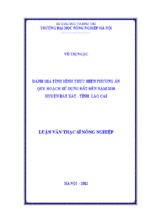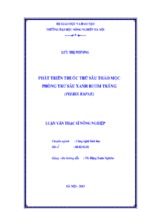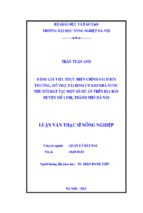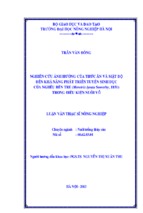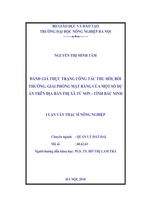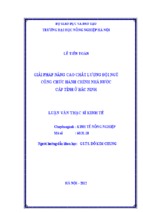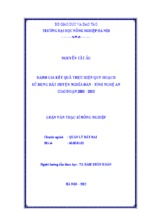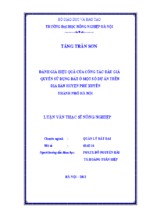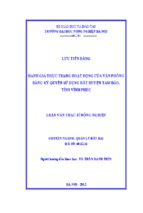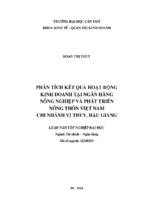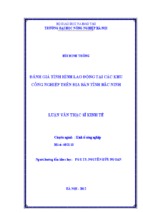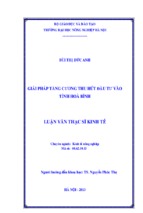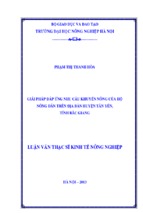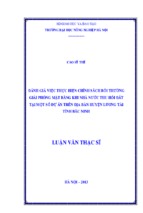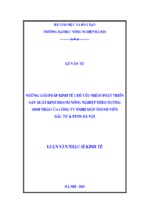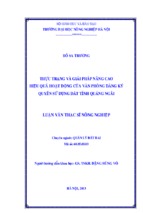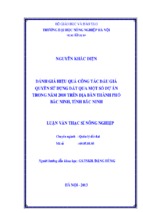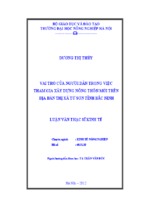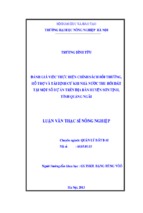VIETNAM NATIONAL UNIVERSITY OF AGRICULTURE
LE MY HANH
DEVELOPMENT OF DRINKING PRODUCT FROM
THE QUINOA SEED (CHENOPODIUM QUINOA)
Major
: Food science and Technology
Code
: 24180560
Supervisor
: Dr. Tran Thi Lan Huon
AGRICULTURAL UNIVERSITY PRESS - 2017
DECLARATION
I hereby declare that this thesis is my own work and effort and that it has not
been submitted anywhere for any degree. Where other sources of information have been
used, they have been acknowledged.
Hanoi, May 10th, 2017
Master candidate
Le My Hanh
i
ACKNOWLEDGEMENTS
I would like to express the deepest thanks to my supervisor Dr. Tran Thi Lan
Huong for her guidance during the time I conduct the research. She provided me the
material to perform all experiments and taught me how stuff works. She opened my
mind for any kind of research conversation, and always being a good listener. I am also
grateful to Msc. Nguyen Huy Bao who taught me how to process data on design expert
software and some skills in Microsoft. He helped me better understand the theories
related to optimization and sensory evaluation. Moreover, he used to encourage me
whenever I was depressed during this study.
Sincerest thanks to my colleagues in the Department of Quality Management and
Food Safety who helped me to do some works in the office. Therefore, I could spend
more time to study and complete my research thesis.
The students in the Faculty of Food science and Technology are Chuc and Linh
who helped me a lot in the experiments of this study. I would like to express my thanks
to them.
Last but most definitely not least, I would like to express my deepest gratitude to
my parents and the rest of the family who always emphasized the importance of
education. It is not the tiniest bit exaggerated to say this thesis wouldn’t exist without
some “parental guidance” throughout my (numerous) years in education.
Hanoi, May 10th, 2017
Master candidate
Le My Hanh
ii
TABLE OF CONTENTS
Declaration ......................................................................................................................... i
Acknowledgements ........................................................................................................... ii
Table of contents .............................................................................................................. iii
List of abbreviations ........................................................................................................ iv
List of tables...................................................................................................................... v
List of figures ................................................................................................................... vi
Thesis abstract................................................................................................................. vii
Chapter 1. Introduction ..................................................................................................... 1
1.1.
Introduction .................................................................................................... 1
1.2.
Objective ........................................................................................................ 2
Chapter 2. Literature Review........................................................................................... 3
2.1.
Overview of material ..................................................................................... 3
2.2.
Cereal and grain for non-alcohol beverage .................................................. 14
Chapter 3. Materials and methods ................................................................................. 18
3.1.
Materials ...................................................................................................... 18
3.2.
Research content .......................................................................................... 18
3.3.
Methods........................................................................................................ 18
Chapter 4. Results and discussion ................................................................................. 26
4.1.
Analysing the main chemical content .......................................................... 26
4.2.
Enzymatic hydrolysis optimization of quinoa starch ................................... 27
4.3.
Effect of sterilization regime (temperature and time) on product
quality .......................................................................................................... 33
Chapter 5. Conclusion and recommendations ............................................................... 40
5.1.
Conclusion ................................................................................................... 40
5.2.
Recommendations ........................................................................................ 40
Reference ...................................................................................................................... 41
Appendix ...................................................................................................................... 50
iii
LIST OF ABBREVIATIONS
Acronym
ANOVA
CFU
db
FAO
ULS
QS
QP
RSM
SICA
WHO
Abbreviations
Analyze of variance
Colony forming unit
Dry basis
Food and Agriculture Organization
Unstructured line scale
Quinoa seed
Quinoa protein
Response surface methodology
Agricultural Census and Information System
World Health Organization
iv
LIST OF TABLES
Table 2.1. Amino acids composition of quinoa seed, barley, soybean, and wheata....... 6
Table 2.2. Comparison of essential amino acids content of barley, corn and
wheat to FAO/WHO suggested requirement ................................................. 7
Table 2.3. Mineral composition whole quinoa seed, dehulled quinoa seed, quinoa
flour, oat, barley (mg/100 g) .......................................................................... 9
Table 3.1. Factors and their levels for the Box-Behnken design .................................. 21
Table 3.2. Experimental design and responses of the dependent variables to the
hydrolysis parameters. ................................................................................. 22
Table 4.1. The main chemical content of quinoa seed (% dry weight)......................... 26
Table 4.2. Amino acid profiles (g/100g protein) .......................................................... 27
Table 4.3. Responses of the dependent variables to the hydrolysis parameters. .......... 28
Table 4.4. Regression coefficients of the predicted second-order polynomial
models for the total sugar content, score of color and score of
appearance.................................................................................................... 29
Table 4.5. Experimental data of verification of predicted technical parameters of
enzyme ......................................................................................................... 33
Table 4.6. The number of microbe of sample sterilized at 1100C (CFU/ml) ................ 35
Table 4.7. The numerous of microbe of sample sterilized at 1100C in 10min
(CFU/ml) ...................................................................................................... 36
v
LIST OF FIGURES
Fig. 2.1. Structure α-amylase. (Payan, 2004). .............................................................. 13
Fig. 2.2. Commercial rice milk ................................................................................... 14
Fig. 2.3. Commercial soy milk .................................................................................... 16
Fig. 2.4. Commercial oat milk..................................................................................... 16
Fig. 3.1. Flow chart of producing quinoa milk ............................................................. 19
Fig. 3.2. Unstructured line scale for training and sensorial evaluation ........................ 25
Fig. 4.1. Surface plot of the total sugar content (Y1) as a function of
concentration of enzyme and temperature at time of 80 min and a
function of temperature and time at concentration of 0,15% enzyme. .......... 30
Fig. 4.2. Surface plot of the score of color (Y2) as a function of concentration of
enzyme and temperature at time of 80 min and as a function of
temperature and time at concentration of 0.15% enzyme . ............................ 31
Fig. 4.3. Surface plot of the score of appearance (Y3) as a function of time and
temperature at concentration of 0.15% enzyme and as a function of
temperature and enzyme concentration at time of 63.1 min. ......................... 32
Fig. 4.4. Contour plot showing optimal values of responses ........................................ 32
Fig. 4.5. Effect of sterilization on color of product ...................................................... 33
Fig. 4.6. Distribution of response level on hedonic scale ............................................. 37
Fig. 4.7. Average scores of quinoa milk and rice milk ................................................. 38
Fig. 4.8. Flow chart of producing process of quinoa milk with the attached
technological parameters ................................................................................ 39
vi
THESIS ABSTRACT
The quinoa milk was processed from quinoa seeed (Chenopodium quinoa) which
has high nutrition value aiming to diversification of beverage products in the market.
Our study focused on the following content
The optimization of enzymatic hydrolysis using response surface methodology to
study the influence of the variables (enzyme concentration, hydrolysis temperature and
hydrolysis time) on the variability of total sugar content and sensory properties (color
and appearance) of quinoa milk. Validation of models showed a good agreement
between experimental results and the predicted responses. The results indicated that all
three variables had a significant impact on responses. The hydrolysis temperature had
the most significant effect on the total sugar content. However, the variable which had
the most significant effect on the score of color and appearance of quinoa milk as well
was hydrolysis time. The optimal hydrolysis parameters were the enzyme concentration
of 0.12%, hydrolysis temperature of 91.9°C and time of 69.6 min according to the
response surface analysis. Under this condition, the total sugar content, score of color
and score of appearance was 83.95mg/ml, 8.47 and 8.5 respectively.
The quality and shelf-life of product is greatly determined by sterilization regime.
The impact of twelve different regimes of heat sterilization, defined by their
combinations of temperature and time (temperature: 1100C, 1150C and 1210C, time:
5min, 7min, 10min and 15min) on the color and microbiological properties of products
was evaluated. In term of color, the three samples which sterilized at 1100C in 5, 7 and
10 min achieved the highest score of color. The sample sterilized at 1100C in 10 min
was the best which successfully met requirements about microbiological criteria
according National technical regulation for soft drinks, 2010 (QCVN 6-2:2010/BYT).
The result of sensory evaluation by panel indicated that the average scores of both
quinoa milk and Korean rice milk that were in the range from “like extremely” to
“dislike extremely” were 6.25 and 6.22 respectively. Although quinoa milk is a new
product in Viet Nam, it was slightly liked by the panel.
Finally, the process of producing quinoa milk was built with the attached
technological parameters.
vii
CHAPTER 1. INTRODUCTION
1.1. INTRODUCTION
Drinks play an important role in human’s life. It provides body not only a
big amount of water involved in the metabolism of the cell but also a huge
amount of nutrients, vitamins and minerals to compensate for the loss of energy
and nutrients have been consumed in the activity of human (Hien, 2006)
Nowadays, because of busy lifestyle, the time spending for consuming food
in daily life is very short. Furthermore, people pay more attention about their
health. Therefore, the ready to drink providing full of nutrition for body is quite
necessary. In Vietnamese beverage industry, consumers tend to use natural
products such as green tea or fruit juice although the price is higher than that of
carbonated beverage. Besides, many kinds of seed is also nutritious source of raw
material used in manufacturing of drinking product for the consumer such as soy
beans, rice, corn...
Quinoa grains have presented in the world 7000 years ago at South America
(Bazile et al., 2016) but it is quite new in Viet Nam. Despite of early appearance, the
potential and benefits of quinoa have recently been known by researchers in other
countries. Studies have been performed in an increasing number of countries. The
number of countries growing quinoa has risen rapidly from 8 in 1980 to 75 in 2014,
with a further 20 countries which sowed quinoa for the first time in 2015 (Bazile and
Baudron, 2015). In Vietnam, quinoa plants were grown and developed in the period
of time between 1986 and 2000 with HV1 specie in many provinces, the yield from
14.0 to 20.6 kg / ha (Trinh Ngoc Duc, 2001). Nowadays, they are grown in Quang
Tri, An Giang province and Viet Nam University of Agriculture. This kind of seed
attracts the attention of many researches in different countries because of its
nutritional value (James, 2009) especially protein. Its protein levels are similar to
those found in milk and higher than those present in cereals such as wheat, rice and
maize (James, 2009). Furthermore, quinoa seed has highest content of bioactive
compounds compared to other cereals and pseudo-cereals (Hirose et al., 2010).
Therefore, we conduct the research on the topic: “Development of drinking
product from the quinoa seed (Chenopodium quinoa)” to diversify of beverage
products in the market.
1
1.2. OBJECTIVE
1.2.1. General objective
The aim of this study was to develop a drinking product from quinoa seed
(quinoa milk) belonging to favorable product family in recent years which help
to diversify of beverage products in the market.
1.2.2. Specific objectives
- Enzymatic hydrolysis optimization of quinoa starch
- Determining the appropriate condition of sterilization
- Determining degree of preference of consumer toward product
- Building the process of producing quinoa milk
2
CHAPTER 2 – LITERATURE REVIEW
2.1. OVERVIEW OF MATERIAL
2.1.1. Quinoa seed
2.1.1.1. History and distribution
Quinoa has been recognized for centuries as an important food crop in the
high Andes of South America (Tapia, 1982). The name quinoa in the Quechua
and Aymara languages means ‘Mother Grain’ and this crop occupied a place of
prominence in the Inca Empire next only to maize (Bhargava and Ohri, 2016).
After that, quinoa seed did not receive much attention from people until the
1980s, the market for quinoa began expanding in Europe and North America
mainly in the health-food sector and the demand was met partly by imports from
South America and by the development of quinoa in new regions outside its
center of origin (Bhargava and Ohri, 2016).
According to Rojas (1998) the geographical distribution of quinoa in the
region extends from 5°N in Southern Colombia, to 43°S in the Xth Region of
Chile. During the last decade, quinoa has been started extensive cultivation in
Chile, Ecuador, Argentina, and Colombia (Rojas, 1998). There were research
projects on quinoa, such as SICA (Agricultural Census and Information System)
of the Agricultural Ministry of Ecuador; Quinuacoche CANOE program
promoted by the Latin American Foundation in Colombia; Provincial Congress
for Quinoa promoted by the Deputies Chamber of Salta, Argentina; Program of
Encouragement for Business Design; and Innovation promoted by the Euro Chile
Foundation (Taboada et al., 2011).
In 1993, a project titled ‘Quinoa-a multipurpose crop’ for EC’s agricultural
diversification was initiated in the European Union (Jacobsen et al., 2003a). This
led to setting up of laboratories in Scotland and France, and field trials in
England, Denmark, the Netherlands and Italy. Quinoa has been evaluated as a
potential crop in Denmark, Poland, Sweden, Italy, and Greece (Bhargava and
Srivastava, 2013). It has also been successfully tested in North America and
Africa and has been cultivated in the US since the early 1980s and commercially
produced since the mid-1980s in the Colorado Rockies, especially in the San
Luis Valley (Bhargava and Srivastava, 2013). The North American Quinoa
3
Producers Association was formed in 1988 and a small processing plant was
started for the crop produced in the area. Production has also been attempted in
California, New Mexico, Oregon, and Washington. In Canada, cultivation is
done in Saskatchewan and Manitoba most of which is organic (Bhargava and
Srivastava, 2013).
The Asian experiment on quinoa introduction has been quite impressive
with the crop showing good adaptation and abundant yield in the Indian
subcontinent. Quinoa was successfully introduced in India in the early 1990s and
exhaustive field trials have proved its cultivation as an alternative winter crop for
the North Indian Plains (Bhargava et al., 2007). It was introduced in Pakistan in
2007 in the central Punjab to lessen the dependence of the common people on
conventional crops (Bhargava and Ohri, 2016). Field tests have been done in
Japan in the climatic conditions of Southern Kanto District of Japan (Ujiie et al.,
2007). Field tests in Kenya have shown seed yield up to 9 t/ha and biomass yield
up to 15 t/ha indicating high seed yield comparable to that in the Andean region
(Mujica et al., 2001). A partnership between the Danish Company Eghojgaard
and the Egyptian Natural Oil Company (NATOIL) has been constituted since the
year 2007 for promoting quinoa in Egypt (Bhargava and Srivastava, 2013).
Quinoa was formally put in field trials in the Sinai Peninsula with 13 varieties
and strains being tested in deserts of South Sinai governorate (near Nuwaiba city)
which proved to be a success (Shams, 2011). Recent introduction in Morocco has
shown a high potetial of adaptation in the country (Hirich et al., 2014).
Today quinoa is presently cultivated or tested in 95 countries of the world.
This global expansion of quinoa looks set to continue as increasing numbers of
countries are testing quinoa (Bazile et al., 2016).
2.1.1.2 Chemical composition of quinoa seed
Quinoa is a very interesting food due to its complete nutritional
characteristics. Some main chemicals of quinoa seed are discussed following
a. Carbohydrate
Starch is the main carbohydrate in quinoa, located in primarily the
perisperm (Prego and Maldonado, 1998). It makes up approximately 58.164.2% of the dry matter, of which 11% is amylose (Repo-Carrasco et al., 2003).
4
Quinoa starch granules are smaller in size than that of common cereals, having
a polygonal form with a diameter of 2 µm. Being rich in amylopectin, it has
excellent freeze-thaw stability and thus is an ideal thickener in frozen foods
and other applications where resistance to retrogradation is desired (Ahamed et
al., 1998).
According to Repo-Carrasco, these starches could provide an interesting
alternative to replace chemically modified starches (Repo-Carrasco and Molina,
1991). Genetic variation of starch granule size in the Bolivian quinoa collection
ranged from 1 to 28 µm, this variable can be used to make different mixtures
with cereals and legumes, and establish the functional nature of quinoa (Rojas et
al., 2010).
b. Protein
The mean protein content reported in the literature for quinoa seed (QS) is
12–23% (Abugoch et al., 2008). Compared to cereal grains, the total protein
content of QS (16.3% dry basis (db)) is higher than that of barley (11% db), rice
(7.5% db), or corn (13.4% db), and is comparable to that of wheat (15.4% db)
(Abugoch et al., 2008). Quinoa contains all ten essential amino acids (Vega‐
Gálvez et al., 2010; Meneguetti et al., 2011). Relative to cereal grains, quinoa
proteins (QPs) are particularly high in lysine, the limiting amino acid in most
cereal grains (Table 2.1). Their essential amino acid balance is excellent because
of a wider amino acid range than in cereals and legumes (Ruales and Nair, 1993),
with higher lysine (5.1–6.4%) and methionine (0.4–1%) contents (Bhargava et
al., 2003; Prakash and Pal, 1998). QPs have higher histidine content than barley,
soy, or wheat proteins, while the methionine and cystine content of quinoa is
adequate for children (2–12 years old) and adults (Table 2.2), it is similar to that
of barley and soy, and lower than the amounts in wheat. According to the
FAO/WHO suggested requirements (Table 2.2) for a 10-year-old children, QPs
have adequate levels of aromatic amino acids (phenylalanine and tyrosine) and
similarly in histidine, isoleucine, threonine, phenylalanine, tyrosine, and valine
contents. By comparison (Table 2.2), lysine and leucine in QPs are limiting
amino acids for 2–5-year-old infants or children, while all the essential amino
acids of this protein are sufficient according to FAO/WHO suggested
requirements for 10–12- year-old children. Therefore, quinoa could be a good
source of proteins for feeding infants and children.
5
Table 2.1. Amino acids composition of quinoa seed, barley,
soybean, and wheata
Quinoa seed
Barley
pearled
Amino acid
Soybean raw
Wheat durum
mg/g protein
Arginine
77.3
50.1
69.5
83.4
Aspartic acid
80.3
62.5
136.3
94
Cysteine
14.4
22.1
12.1
20.5
Glycine
49.2
36.2
38.6
45.5
132.1
261.2
151
195.1
Histidine
28.8
22.5
26.7
23.5
Isoleucine
35.7
36.5
44.5
43.2
Leucine
59.5
98.2
72
82.8
Lysine
54.2
37.2
57.8
36.2
Methyonine
21.8
19.2
10.6
23.5
Phenylalanine
29.8
34
38.6
35.8
Serine
40.2
42.2
50
52.6
Threonine
29.8
34
38.6
35.8
Tryphtophan
11.8
16.6
12.2
11.5
Tyrosine
18.9
28.7
36.2
33.4
Valine
42.1
49
47.6
61.1
Alanine
41.6
39
42.2
58
Glutamic acid
Source:
6
a
USDA (2005)
Table 2.2. Comparison of essential amino acids content of barley, corn and
wheat to FAO/WHO suggested requirement
Quinoa
seeda
Barley
pearled
a
Soybeans
raw
Wheat
durum
a
FAO/WHO suggested
requirementsb
Amino acids
mg/g protein
2-5year old
10-12year
old
Adu
-lt
Histidine
28.8
22.5
27.6
23.5
19
19
16
Isoleucine
35.7
36.5
44.5
38.9
28
28
28
Leucine
59.5
98.2
72
68.1
66
44
19
Lysine
54.2
37.2
57.8
22.1
58
44
16
36.2
41.3
28.9
22.7
25
22
17
Phenyalanine
and Tyrosine
60.9
84.7
84.8
85.9
63
22
19
Threonine
29.8
34
38.6
26.7
34
28
9
Tryptophan
11.4
16.6
12
12.8
11
9
5
Valine
42.1
49
57.1
41.6
35
25
13
Methyonnine
and Cystine
Source: a USDA (2005); b Friedman and Brandon (2001))
c. Lipid
QS have been considered an alternative oilseed crop due to their lipidic
fraction (Koziol, 1993). Besides the high content and good biological quality of
their proteins, QS have an interesting lipid composition of about 1.8–9.5%
(Wood et al., 1993; Ranhotra et al., 1993). Quinoa has an oil content (7% dry
basis) higher than corn (4.9% dry basis) and lower than soy (20.9% dry basis)
(Koziol, 1993). According to Przybylski et al. (1994), QS lipids contain high
amounts of neutral lipids in all the seed fractions analyzed (Przybylski et al.,
1994). Triglycerides are the major fraction present, accounting for over 50% of
the neutral lipids. Diglycerides are present in whole seeds and contribute 20% of
the neutral lipid fraction. Lysophosphatidyl ethanolamine and phosphatidyl
7
choline are the most abundant (57%) of the total polar lipids (Przybylski et al.,
1994). Some researchers have characterized the fatty acid composition of quinoa
lipids as follows: total saturated 19–12.3%, mainly palmitic acid; total
monounsaturated 25–28.7%, mainly oleic acid, and total polyunsaturated
58.3%—chiefly linoleic acid (about 90%) ( Oshodi, 1999; Ranhotra et al., 1993;
Ryan et al., 2007). Omega-6 and omega-3 fatty acids are essential fatty acids
because they cannot be synthesized by humans, who must obtain them from
foods. The essential fatty acids are metabolized to longer chain fatty acids of 20
and 22 carbon atoms. Linoleic acid is metabolized to arachidonic acid and
linolenic acid to eicosapentaenoic acid (EPA) and docosahexaenoic acid (DHA).
EPA and DHA play important roles in prostaglandin metabolism, thrombosis and
atherosclerosis, immunology and inflammation, and membrane function (
Youdim et al., 2000). The fatty acid profile of QS is similar to corn and soybean
oil (Youdim et al., 2000; Kozioł, 1992; Oshodi, 1999). Essential fatty acids are
important acids, like linoleic and linolenic acids, that are necessary substrates in
animal metabolism. Linoleic acid (C18:2) is one of the most abundant
polyunsaturated fatty acids (PUFA ) identified in QS; PUFAs have several
positive effects on cardiovascular disease ( Keys and Parlin, 1966) and improved
insulin sensitivity (Lovejoy, 1999).
The oil fraction of QS has high quality and is highly nutritious, based on the
fact that it has a high degree of unsaturation, with a polyunsaturation index of
3.9–4.7. In this fraction, not only the fatty acid composition is important. Another
important feature is the natural presence of a high amount of vitamin E ( atocopherol), 0.59–2.6 mg/100 g in the seeds (Ryan et al., 2007), which acts as a
natural defense against lipid oxidation (Ng et al., 2007). This fact could lead to a
very stable oil from QS, with vitamin E acting as a natural antioxidant. The
tocopherol content in quinoa whole flour has been reported as 3.1–5.5 mg/100 g
(Ruales and Nair, 1993; Ryan et al., 2007). The chemical stability of the lipids in
quinoa flour was studied by Ng et al. (2007), who found that the lipids were
stable during 30 days, and this stability is due to vitamin E present naturally.
d. Vitamin and minerals
QS are also rich in micronutrients such as minerals and vitamins. Table 2.3
shows the mineral content of QS and quinoa flour. The main minerals are
potassium, phosphorus, and magnesium (Table 2.3). According to the National
8
Academy of Sciences (2004) the magnesium, manganese, copper, and iron
present in 100 g of QS cover the daily needs of infants and adults, while the
phosphorus and zinc content in 100g is sufficient for children, but covers 40–
60% of the daily needs of adults. The potassium content can contribute between
18% and 22% of infant and adult requirements, while the calcium content can
contribute 10% of the requirements. However, the mineral content of QS is
higher than that of cereals like oat (except phosphorus) or barley, especially that
of potassium, magnesium, and calcium (Table 2.3).
In their research, Konishi et al. (2004) found that abrasion of QS (for
saponin elimination) caused specifically a decrease in calcium content (Konishi
et al., 2004). On the other hand, they found that the distribution of minerals in
QS revealed that phosphorus and magnesium were localized in embryonic
tissue,while calcium and potassium were present in the pericarp (Table 2.3).
Table 2.3. Mineral composition whole quinoa seed, dehulled quinoa seed,
quinoa flour, oat, barley (mg/100 g)
Whole QSa
Dehulled QSa
Quinoa flour b,c
Calcium
86.3
55.1
70-86
58
29
Phosphorous
411
414.9
22-462
734
221
Potassium
732
656
714-855
566
280
Magnesium
502
467.9
161-232
235
79
Iron
15
14.2
2.6-6.3
5.4
2.5
Manganese
n.r
n.r
3.5
5.6
1.3
Copper
n.r
n.r
0.7-7.6
0.4
0.4
4
4
3.2-3.8
3.11
2.1
n.r
n.r
2.7-93
4
9
Zinc
Sodium
Oatd
Barleyd
Note: n.r.: not reported.
Source:a Konishi et al. (2004); b Ranhotra et al. (1993);
c
Oshodi et al. (1999); d USDA (2005)
The vitamin content (Table 2.4) is also interesting, because QS have high
levels of vitamin B6 and total folate, whose amounts in 100g can cover the
requirements of children and adults. The riboflavin content in 100g contributes
9
80% of the daily needs of children and 40% of those of adults (National
Academy of Sciences, 2004). The niacin content does not cover the daily needs,
but is beneficial in the diet. Thiamin values in quinoa are lower than those in oat
or barley, but those of niacin, riboflavin, vitamin B6, and total folate are higher
(Ranhotra et al., 1993).
Table 2.4. Vitamin composition quinoa flour, oat, barley (mg/100g)
Quinoa flour a,b
Oatb
Barleyb
Thiamin
0.29-0.36
0.763
0.191
Riboflavin
0.30-0.32
0.139
0.114
Niacin
1.24-1.52
0.961
4.604
B6
0.487b
0.119
0.260
Folate total
0.184b
0.056
0.023
Source: a Ranhotra et al. (1993); b USDA (2005)
e. Saponin
Saponins are a wide group of glycosides found in plants; their name comes
from the plant genus Saponaria, whose root was used as soap (sapo, onis ¼ soap)
(Sparg et al., 2004); so they are water soluble and form foaming solutions.
Saponins are steroid or triterpenoid glycosides, with the latter found more
commonly in crops (Francis et al., 2002). These compounds have a bitter taste
and are considered toxic in large amounts. They are present in the whole quinoa
plant; where their natural function is to defend the plant from the external
medium. In general, QSs contain saponins in the seed coat (except sweet
varieties, without saponin or containing less than 0.11%). Saponins are the main
antinutritional factor present in the seed cover (Ruales and Nair, 1994); studies in
rats revealed that animals fed with unwashed quinoa diets showed growth
damage and reduced food conversion efficiency (Gee et al., 1996). According to
their chemical structure, saponins can be partially removed by washing with
water (Chauhan et al., 1999), but even after washing some saponin remains in the
seed. Zhu et al. (2002) recommended the use of slightly alkaline water rather
than neutral water to debitter QSs. Brady et al. (2007) have reported that the
bitter taste imparted by saponins could potentially be reduced by extrusion and
roasting processes.
10
Saponins are compounds that contain sugar chains and a triterpenoid
aglycone (sapogenin) in their structure (Sparg et al., 2004). They are categorized
according to the number of sugar chains in their structure as mono-, di-, or
tridesmosidic. Four main structures of sapogenins have been identified in quinoa:
doleanolic
acid,
hederagenin,
phyolaccagenic
acid,
and
30-omethylspergulagenat (Zhu et al., 2002). The major carbohydrates are glucose,
arabinose and galactose. Besides, 20 triterpene saponins have been isolated from
different parts of Chenopodium quinoa (flowers, fruits, seed coats, and seeds)
(Zhu et al., 2002; Kuljanabhagavad et al., 2008).
The sapogenin content in seeds of sweet genotypes varied from 0.02%
to 0.04% and in seeds of bitter genotypes from 0.14% to 2.3% (Güçlü-Üstündağ
and Mazza, 2007). These values are higher than those in soybean and oat, but
lower than in green pea and yucca (Güçlü-Üstündağ and Mazza, 2007).
2.1.1.3. Present and future uses of quinoa seed
Quinoa is well adapted to extreme weather conditions, and it is currently
produced by Bolivia, Peru, Ecuador, Chile, Argentina, and Colombia. It is
basically exported as dry and saponin-free quinoa, with Europe and the USA as
the main consumers. Future uses can be wide-ranging, like textured and
fermented products. There are many ways in which it can be consumed: cooked,
AS flour, extruded. Quinoa meat substitute has been introduced in Europe
(Tellers, 2008). There are several developments with quinoa flour at a smaller
scale, like bread, cookies, muffins, pasta, snacks, drinks, flakes, breakfast cereals,
baby foods, beer, diet supplements, and extrudates (Ahamed et al., 1997;
Bhargava et al., 2006; Caperuto et al., 2001; Chauhan et al., 1992; Doğan and
Karwe, 2003). Coulter and Lorenz (1991) obtained extruded corn grits–quinoa
blends that had high protein quality and solubility and an acceptable sensory
evaluation (Coulter and Lorenz, 1991). Caperuto et al. (2000) developed glutenfree quinoa spaghetti and obtained a product without loss of solids and
acceptable weight and volume increase upon cooking, while the adhesiveness of
the cooked product was not very high (Caperuto et al., 2001). The product was
sensorially accepted by the panelists.
Quinoa flour does not have good baking properties like wheat gluten
proteins. The wheat proteins are able to form a viscoelastic network when flour is
11
mixed with water to form dough, and these viscoelastic properties allow the use
of wheat to produce bread and other processed foods (Shewry et al., 1995).
Quinoa bread has been made by including 10% of wheat flour (Chauhan et al.,
1992). There are some gluten-free products without good baking properties for
celiac groups, and quinoa provides an opportunity to develop gluten-free cerealbased products (Gallagher et al., 2004). Dogan and Karwe (2003) showed that
quinoa can be used to make novel, healthy, extruded, snack-type food products
(Doğan and Karwe, 2003). They got a good product with maximum expansion,
minimum density, high degree of gelatinization, and low water solubility index
(16% feed moisture content, 1300C die temperature, and 375 rpm screw speed).
Quinoa has shown a high nutritional value and only recently is being used as a
novel functional food. However, it is very important to increase and promote QS
production, diversify production, and enhance its consumption. An important
aspect to consider for promoting quinoa consumption is to inform consumers of
the good properties of quinoa and let them incorporate it in their daily diet as a
healthy, nutritious, good tasting, and versatile food. Alternatively, it is necessary
to develop new functional products that can be available on the market for the
ordinary user, and scale them up to industrial level.
2.1.2. TermamylR 120L (Alpha amylase)
TermamylR 120L is a kind of Bacterial thermophilic alpha-amylase which
can act at pH=6.0-6.4 in pre-liquefaction at 80-850C and continuous liquefaction
at 105-1100C (Chandrasekaran, 2015). It belongs to a family of endo-amylases
that catalysis the initial hydrolysis of starch into shorter oligosaccharides through
the cleavage of α-D-(1-4) glycosidic bonds ( Iulek et al., 2000). Neither terminal
glucose residues nor α-1,6-linkages can be cleaved by α-amylase (Whitcomb and
Lowe, 2007). The end products of α-amylase action are oligosaccharides with
varying length with an α-configuration and α-limit dextrins (Van Der Maarel et
al., 2002), which constitute a mixture of maltose, maltotriose, and branched
oligosaccharides of 6-8 glucose units that contain both α-1,4 and α-1,6 linkages
(Whitcomb and Lowe, 2007). Others amylolytic enzymes participate in the
process of starch breakdown, but the contribution of α-amylase is the most
important for the initiation of this process (Tangphatsornruang et al., 2005).
The amylase has a three-dimensional structure capable of binding to
substrate and, by the action of highly specific catalytic groups, promote the
12
- Xem thêm -


